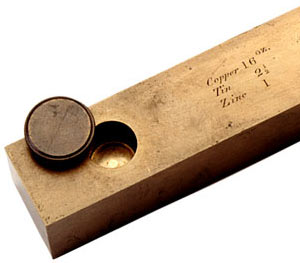On 1 July 1959 the U.S. redefined the yard and pound to align U.S. customary measures with international standards.
Ever since the Mendenhall Order of 1893, U.S. customary units have been defined in terms of metric units. However, since then, “minor but troublesome discrepancies” had developed in the definitions of the customary units.
On 1 July 1959 the National Bureau of Standards announced that “as a result of study and negotiation, it has developed that most of the discrepancies can be resolved and a high degree of measurement uniformity obtained by small refinements of the ratios defined in the 1893–94 bulletins relating the yard and the pound to the meter and kilogram.”
The newly defined International Yard and International Pound, the announcement explained, “will be used by the National Standards Laboratories of Australia, Canada, New Zealand, South Africa, and the United Kingdom; thus there will be brought about international accord on the yard and pound by the English-speaking nations of the world, in precise measurements involving these basic units.”
The new U.S. customary length units are approximately 2 parts in 1 million smaller than the old units, and the new U.S. customary weight units are approximately 1 part in 10 million smaller than the old.
Yard, foot, inch, etc.

Bronze Yard No. 11 defined the standard yard of the U.S. from about 1857 until 1893, when the yard was redefined in terms of the meter. This bronze bar, 1 inch by 1 inch in cross section and 38 inches long, has an inset gold plug in a cylindrical well at each end; the distance between the lines engraved on the gold plugs defined the length of the yard. It was built of the same material and form as the British Imperial Yard legalized in 1855, and was presented to the U.S. by Great Britain in 1856.
Effective 1 July 1959, the U.S. customary distance units were redefined by the relationship
1 yard = 0.9144 meter
This value, designated the International Yard — and from which the other length units are derived — replaced the previous definition, established in 1893 by the Mendenhall Order, in which the yard had been defined as 3600/3937 meter.
Standard inch
Although the new length of the inch was not “official” in the U.S. until 1959, in practice the inch had already been redefined as exactly 25.4 mm by many organizations.
The American Standards Association (now ANSI) adopted the 25.4-millimeter inch in 1933, and the National Advisory Committee for Aeronautics (now NASA) adopted the 25.4-milliimeter inch in 1952. The new inch was also adopted by many standards organizations in other countries. (Previously, the U.S. inch was approximately 25.400 050 8 mm).
U.S. Survey Foot
There is one exception to the new definitions. The term “U.S. Survey Foot” refers to the foot defined by the old relationship — approximately 0.304 800 609 m, versus the new International Foot of exactly 0.3048 m — and is used to interpret data expressed in feet from U.S. geodetic surveys.
International Nautical Mile
Although the length of the statute mile changed as a result of the 1959 redefinition, the nautical mile was not affected. The nautical mile had been defined as exactly 1852 meters in 1954 (see theNBS announcement), and this length did not change.
However, the length of the nautical mile, expressed in feet, did change: previously, a nautical mile was 6 076.103 333 feet, but now a nautical mile is approximately 6 076.115 486 feet. The difference, of course, is because of the change in length of the foot, not a change in length of the nautical mile.
Pound, ounce, grain, etc.
Effective 1 July 1959, the U.S. customary avoirdupois mass units were redefined by the relationship
1 pound (avoirdupois) = 0.453 592 37 kilogram
This value, designated the International Pound, replaced the previous definition, established in 1893 by the Mendenhall Order with the relationship 2.204 62 pounds = 1 kilogram and revised in an 1894 amendment to 2.204 622 34 pounds = 1 kilogram. As a result, the “old” U.S. pound was approximately 0.453 592 428 kg.
Other customary avoirdupois mass units such as the ounce and grain similarly changed to correspond to the new definition.
The NBS announcement
For more details, read the 1959 NBS announcement of the refinement of values for the yard and the pound.
Back to USMA home.
Copyright © 2009, US Metric Association (USMA), Inc. All rights reserved.
This page prepared by USMA member Gary Brown.
Updated: 2009-06-13